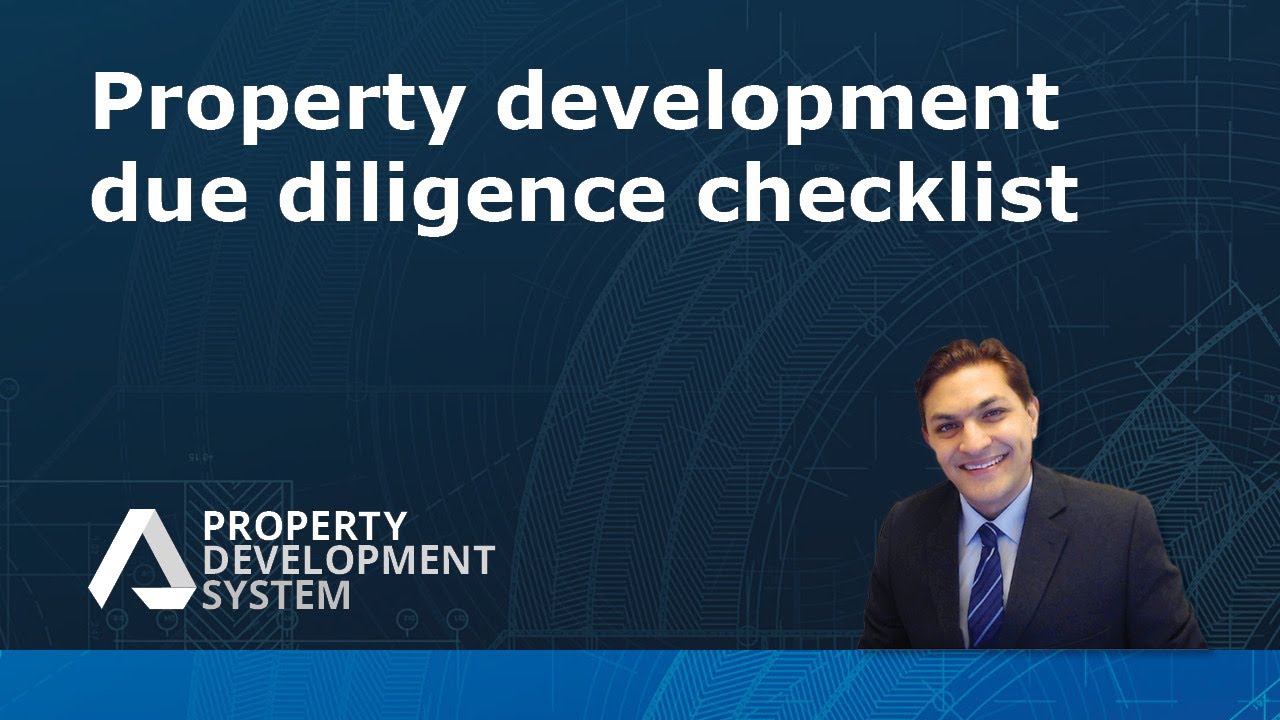My 26 Questions Property Development Due Diligence Checklist For Real Estate Development
There’s no doubt that starting your first development can be a daunting process and the reason I always refer to my specimen due diligence checklist for real estate development.
Despite what some ‘gurus’ might have you believe, there is no mystery behind why some development projects are a success and others are doomed from the outset.
It’s true that you’ll never completely eliminate risk from a development project, however, you can dramatically reduce your exposure to risk if you know the right questions to ask when vetting an opportunity.
Today I’m going to share with you the 26 Property Development Due Diligence Questions I use every time I vet an opportunity.
These questions aren’t rocket science, yet many would-be investors lack the discipline and data-focus to methodically work through each of these questions point-by-point and ensure that an opportunity ticks ALL the right boxes.
Let me assure you, any time you save taking shortcuts with your due diligence will almost certainly come back to severely bite you down the track.
It doesn’t take a ton of time to get all the answers that you need – especially considering what’s on the line – so I encourage you to make these 26 questions a part of your own due diligence development process as they are mine.
Watch Video: Property Development Due Diligence Checklist For Real Estate Development
What Is Property Due Diligence?
Definition: Property Due Diligence
A Process Of Steps Taken In Order Satisfy Legal Requirements And Ascertain The Risks And Advantages Of The Transaction, Especially When Buying Or Selling Property.
This article is NOT intended to be a comprehensive guide to due diligence but rather a practical resource you can start using immediately to vet development opportunities.
Learn More
Why Do We Undertake Property Development Due Diligence?
The huge number of development opportunities in Australia can be a double edge sword for would-be developers.
Sure, more opportunities can mean more potential for profits, but for some investors, the prospect of making the “wrong” decision can be so daunting that they take no action at all. This is known as ‘analysis paralysis’.
Savvy investors overcome perceived risks and analysis paralysis by using a strict due diligence process that allows them to cull low-quality or high-risk opportunities before over-investing their time analyzing a project in great depth.
26 Questions To Ask When Conducting Property Development Due Diligence
All 26 factors listed below play a crucial role in the approval, construction and sale of your development.
Believe me, it is MUCH better to do your homework now than it is to recognise an issue down the track and have your project grind to a frustrating and expensive halt.
With this in mind, how do your opportunities compare against the following Property Development Due Diligence Checklist?

1. Public Transport
Easy access to train stations, bus stands, highways, freeways form a prerequisite for workers who are dependent on public transport for commuting.
Proximity to public transport can often be the difference between shorter and longer days on the market when you are trying to sell. Keeping an eye on future transport infrastructure can help in securing a lucrative deal.
2. Schools & Education Facilities
Younger families require proximity to schools and prefer to live close to primary and secondary schools.
3. Shopping & Retail Centres
Everyone needs to buy groceries, so if you are close to a supermarket it’s a bonus and if you are close to a major shopping centre, it’s a double bonus.
Some other factors which can equally attract people are, place of worship, hospitals, recreational activities etc.
4. Total Area
Total area of the site must be checked carefully, as a few extra square meters could mean the difference between 3 or 4 townhouses.
5. Usable Area
For a developer, it is important to understand the total area that can be used to build. Usually, medium densities are about 60% of the total area, but this can vary considerably in high-density housing development to medium density to low density.
Setbacks are also important as they limit the amount of usable area.
6. Topography
Topography is another important factor in considering a site for development. Ideally a flat site with a slight fall to allow for storm water run-off.
A sloping site will cost more, as expensive retaining walls will have to be accounted for. Sites that slope towards the street are better than those that fall away, as it allows for convenient vehicular entry and exit.
7. Vegetation
Property development sites with extensive trees and vegetation, do both add character and take away value. For smaller projects, saving trees can be a costly exercise.
It is imperative that you look into council overlays that govern the site before you get into the project.
It’s not always a problem, but a VPO (Vegetation Protection Overlay) can prevent a developer from achieving the highest best possible use of the site
8. Soil
The bearing power of soil becomes more and more important for large multi-story projects. You should avoid “fill-in ground” i.e. where the top portion consists of soil that has been deposited there from excavations.
Clay is another dangerous soil to build on. A soil test can help you determine the type of soil that is present on your development site.
9. Neighborhood Quality
A well planned and tidy streetscape will enhance the value of the development project, while a poorly planned suburb with untidy streets will devalue your investment property.
10. Storm Water
Storm water or drainage patterns must be inspected to make sure that water flows off the property easily. Poor drainage will incur more costs in order to correct the problem.
Avoid sites where flooding could occur such as low-lying or swampy areas, streams and watercourses.
You should study the local flood zones to make sure that the site you are purchasing is not prone to flooding.
11. Traffic
Neighborhood traffic patterns must be researched to see if access to the development is easy or difficult. High traffic can cause congestion, making entry and exit difficult.
Information about the level of traffic in the area can be obtained by general observation or discussions with the local traffic department.
A traffic engineer can provide more accurate information.
12. Noise Levels
Property development sites located adjacent to noisy businesses, recreational facilities, busy roads, children’s playgrounds and industrial sites can lose their value.
13. Availability Of Services
Services like phone, water, sewerage, electricity, gas and cable television services are vital for all properties.
These days with increased Internet usage and the onset it is important to check if the cabling in the area can handle high demand.
14. Waste Disposal
The disposal of household waste is critical. Access to a waste tip is more important to a new subdivision where new homes are being established, as a large amount of building waste is created, compared to more established areas.
You should check the regularity of waste collection – for everyday and recycled waste – and if the local council provides hard and green waste collection.
Points 15-26 Relate To Information In The Vendor Statement (Section 32)
Section 32 or a Disclosure Statement is required under the Sale of Land Act to be given by the vendor to a purchaser.
This document discloses certain information about the property being sold. Regardless of the type of property (residential, commercial, rural or industrial), a sale must not proceed until a vendor signed section 32 / Disclosure Statement has been provided as part of the contract documentation.
15. The Subject Matter Of The Sale
What are you looking at purchasing?
- Is it vacant land?
- Land with improvements?
- Where are the boundaries?
- Encroachments on or by the property?
- If unclear, it is a good practice to get an identification survey done on the property.
16. What Type Of Land Title Are You Dealing With?
17. Notations On The Title
18. Vendor Ownership
- Is the vendor the registered proprietor?
- Are there any mortgages on the property?
- Are there any caveats, court orders or writs on the property?
19. Statutory Authorities
Searches and enquiries with statutory authorities can reveal whether any government or statutory authority has any current or intended future interest in the land (for example, compulsory acquisition). As a property developer, you should check the planning issues and local council’s residential zoning.
- Does current zoning allow your proposed development type?
- Any previous development consent conditions that still apply?
IMPORTANT
Section 32 must contain the following disclosures if they apply to the property to be sold…
20. Building
- Notification of any building works at the property in the previous 6 years (or 7 years if the property is sold by an owner-builder).
- Insurance and guarantees of any building works carried out.
- Registered easements, covenants or restrictions over the land.
- An easement is the right to use the land of another or a right to prevent the owner of that land from using that land in a particular manner, such as a restriction from erecting a building over the pipes used to supply water to the land.
- Covenants are rules or restriction imposed on the owner regarding the upkeep or use of land, such as the height of a fence permitted or the number of dwellings permitted to be built on the land.
21. Planning And Road Access To The Land
The name of the local shire or council, the geographical zoning, how the property is going to be used and the road access to the land.
22. Outgoings And Statutory Charges
Outgoings and charges against the land such as council and water rates, land tax etc.
23. Warning Notice
A warning notice to the purchaser that they should make their own enquiries about the permitted use of the land.
24. Services
Details about utilities (gas, electricity, water and sewerage, telephone) connected to the land and the names of the Authorities supplying the service.
25. Title
- A copy of the Certificate of Title or in the case of land title by the chain of title, a copy of the last conveyance in the chain.
- Existing registered or unregistered mortgages over the land.
- Proof of the right to sell the property if the vendor is not the registered owner, such as a bank’s right to sell in the situation of a mortgagee sale.
- A copy of the registered plan of subdivision (if it applies, ex, Off the plan sales)
26. Owners Corporation (Body Corporate)
If the title forms part of an Owners Corporation, then a certificate stamped with the Owners Corporation seal must be provided. The certificate outlines the costs to the lot owner of:
- Fees and monies outstanding
- Proposed fees or costs
- Insurance
- Repairs and maintenance costs.
It will also include details of the Owners Corporation manager, services provided to a lot of owners, a copy of the Owners Corporation rules, and legal matters affecting Owners Corporation, the lot owner or the common areas of the Owners Corporation.
What Next?
Do you need to run through ALL 26 of these questions every time you want to conduct property development due diligence? Of course not, that would be a good way to wind with a severe case of analysis paralysis.
Some factors are flexible. Others, like the location of the block, are completely out of your control.
Take a common-sense approach to your property development due diligence.
I recommend creating a shortlist of the most important factors that you can quickly use to vet opportunities without investing too much time. If they don’t, just move on and focus your attention on opportunities that do.
Putting It To Practice
Due diligence isn’t a set and forget process and these 26 questions are just the start.
For further reading, I recommend you read The Ultimate Guide to Getting Started in Property Development as well as Property Development Feasibility Study Guide.
Savvy developers will continue to look at increasing granular factors as they progress through the various stages of their development projects, always hoping for the best and pre-empting and preparing for the worst.
If you methodically work through these 26 questions – especially in the early stages of your project – I’m certain you’ll avoid many of the common mistakes that other developers learn the hard way.
FAQs
How do you do due diligence in property development?
Determine whether you will be able to build whatever you want on the site. Decide whether you will be capable of achieving the profit margin you require to do a thorough feasibility analysis for the project.
Identify any potential programme delays or unexpected construction issues and factor in any feasibility calculations.
What is due diligence in real estate development?
Before buying a house, check to see if the title to the land is fair. Financial due diligence assures that the sale of the property will not block by tax liens or judgements against it.
Your title agency should offer proof of current tax payment amounts in addition to looking for liens.




